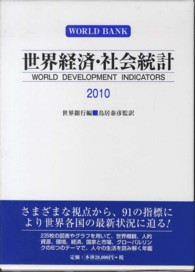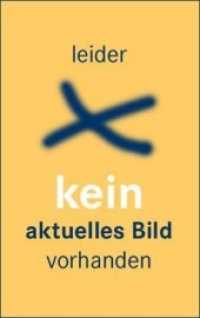- ホーム
- > 洋書
- > 英文書
- > Science / Mathematics
Full Description
Students entering the food processing stream need to acquire knowledge of concepts and analytical skills together with the knowledge of their applications. Food Engineering: Principles and Practices explains the different unit operations in food processing with an emphasis on the principles of food engineering as well as the different types of equipment used for the purpose.
An approach in which propounding concepts and theory is immediately followed by numerical examples makes this book unique among food engineering textbooks. The examples, which are thoroughly explicated, have been taken, in general, from different competitive examinations and have been selected with practical applications for a better appreciation and understanding by the students. In the case of equipment, the constructional and operational features are discussed along with the specialty features of these types of equipment for better understanding their applications.
Key Features:
Merges a presentation of food engineering fundamentals with a discussion of unit operations and food processing equipment
Reviews concepts comprehensively with suitable illustrations and problems
Provides an adequate number of examples with different levels of difficulty to give ample practice to students
Explains equipment units in three broad subheadings: construction and operation, salient features, and applications
This book is written as a textbook for students of food processing and food technology. Therefore, the book is meant for undergraduate and graduate students pursuing food processing and food technology courses. It also serves as a reference book for shop floor professionals and food processing consultants.
Contents
1. Introduction. SECTION A: BASIC CONCEPTS AND PRINCIPLES. 2. Dimensions and Units. 3. Material and Energy Balance. 4. Reaction Kinetics. 5. Psychrometry. 6. Fluid Properties and Flow Behaviours. 7. Heat and Mass Transfer. 8. Refrigeration and Airconditioning. 9. Water Activity and Thermo-Microbiology. SECTION B: UNIT OPERATIONS. B1. Primary processing, separation, size reduction and mixing. 10. Primary Processing. 11. Size Reduction. 12. Mechanical Separation. 13. Extraction. 14. Mixing and Emulsification. B2. Processing involving application of heat 15. Heat Exchange. 16. Thermal Processing. 17. Evaporation. 18. Distillation. 19. Crystallisation. 20. Extrusion. 21. Ohmic, Infrared and Dielectric Heating. B3. Processing involving removal of heat or moisture. 22. Drying. 23. Chilling and Freezing. B4. Processing at/ near ambient temperature 24. Non-Thermal Processing. 25. Food Fermentation and Biotechnology Applications. 26. Nanomaterial Utilisation in Food Processing. B5. Food Packaging and material handling 27. Food Packaging. 28. Material Handling. B6. Food quality, safety and waste disposal 29. Shelf-Life Estimation of Food Products. 30. Food Quality, Safety and Hygeine. 31. Effluent Treatment. A. Annexures







